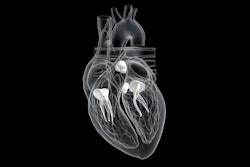A multiphase CT-based deep learning (DL) algorithm shows comparable performance as radiologists for identifying benign small renal masses (SRMs), including lesions of 1 cm or less, researchers have found.
Based on their results, a team led by Chenchen Dai, MD, of Fudan University in Shanghai, China, believe that their deep-learning model could facilitate active surveillance of small benign renal masses. The study was published May 14 in Radiology.
"[Our] developed multiphase CT-based deep learning (DL) algorithm for identifying small [equal to or less than 3 cm] and subcentimeter … benign renal masses demonstrated comparable performance with that of urological radiologists," the group wrote.
More SRMs are found due to use of modern imaging modalities and an increase in surgery for suspected cancer, the team noted. But most of these lesions are benign or indolent. That's why it's crucial to differentiate between the two, Dai and colleagues explained.
The investigators developed and validated a deep-learning algorithm for the identification of benign small renal masses on contrast-enhanced, multiphase CT imaging, then conducted a study that included 1,703 patients with a single renal mass each.
They developed the algorithm using data from one hospital between 2009 and 2021, dividing patients into training and internal test sets with a ratio of eight to two. Between 2013 and 2021, they conducted external testing of the algorithm using data from five hospitals, then between 2021 and 2022, created a prospective test set with data from one hospital. They assessed the algorithm's performance using the area under the receiver operating curve (AUC), comparing it to seven radiologist readers.
The data sets included the following:
- Retrospective data set: 1,063 lesions (874 in the training set, 189 internal test set)
- Multicenter external test set: 537 lesions (12.3% of total, 66 benign) with 89 lesions equal to or less than 1 cm (16.6%)
- Prospective test set: 103 lesions (13.6% of total, 14 benign) with 20 lesions equal to or less than 1 cm (19.4%)
The algorithm performed comparably to the radiologist readers on each test set, the authors reported:
| Deep-learning algorithm performance for identifying benign renal masses compared with radiologist readers | ||
|---|---|---|
| Type of test set | Radiologist readers | Deep-learning algorithm |
| External test set | 0.84 | 0.8 |
| Prospective test set | 0.92 | 0.87 |
| External test set, subcentimeter lesions | 0.81 | 0.74 |
None of the differences were statistically significant.
"We believe our deep learning algorithm can facilitate screening of small benign renal masses for active surveillance and potentially reduce unnecessary surgical intervention for benign lesions," the investigators concluded.
The complete study can be found here.




















